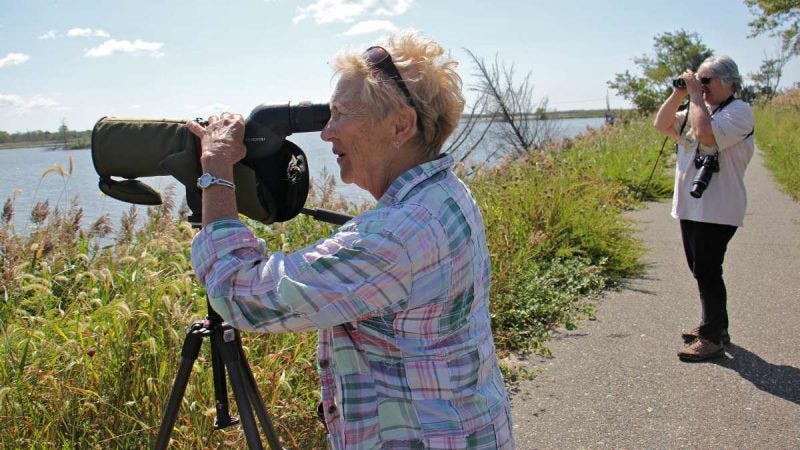Birdwatchers delight in rare sights in South Jersey
Linda Matula is from New Jersey, but retired to Bucks County, Pennsylvania. Every year, she comes back to South Jersey for two weeks.
“I’m here a week in May and a week in September,” she said. “When I come down, my job is to bird my brains out. It’s migration.”
Matula recently set up her digital spotting scope on a path cutting through a marsh in the Heislerville Wildlife Management Area in Cumberland County. She was there for one thing: the roseate spoonbill.
“Where are you?” said Matula as she scanned the reed grass.
The roseate spoonbill’s natural habitat is Florida. It really has no business being in New Jersey. But there it was, on the edge of a field of marsh reeds, hanging out with some egrets and a great blue heron. At about 3 feet high and pink, it stands out.
“It’s pale. It’s not pink-pink. We think it might be a young bird,” said Mary Watkins, who came up from behind Matula with her own spotting scope. “But it’s pink enough.”
Watkins of Bridgeton, New Jersey, is a volunteer tour guide with the Cape May Bird Observatory. This obscure spot, sandwiched between a small marina and nothing at all, has become a daily pilgrimage for her as birders clamor for a peek at “big pink.”
They also go to Cape May Point, where several huge wood storks — standing 4 feet high with a 6-foot wing span — have been spotted. They normally roost in Texas, Georgia, and South Carolina.
Many think these wading birds are here because the recent hurricanes in Texas and Florida took them off their normal migration course.
But Watkins doesn’t think so.
“They were here before hurricane season, so we can’t say that’s what brought them here,” she said. “But it might be what’s keeping them here. They might not want to go back down until things settle.”
This kind of activity is rare, but not unprecedented. Many birds get a wild hair after breeding and wander further than normal. A few other roseate spoonbills have been spotted in Pennsylvania in August.
Ornithologists don’t know exactly why birds wander so far afield. It could be linked to climate change, as warmer temperatures allow birds to venture farther north. Sometimes, the avian pioneers push the boundaries permanently for subsequent generations; on the other hand, many of them don’t survive.
Andrew Dreelin, an interpreter at the Cape May Bird Observatory, chalks up their wanderlust to being an impetuous teenager.
“They are the 1 percent that decides to be adventurous and prospect for new territory,” he said. “Most of the time, in the long term, it doesn’t work.”
So the humans migrating to the observatory are enjoying their rare sight of the roseate spoonbill. It may be nearly 80 degrees in South Jersey this weekend, but to birders it feels like Christmas.
WHYY is your source for fact-based, in-depth journalism and information. As a nonprofit organization, we rely on financial support from readers like you. Please give today.












